Review of the Addlink A92 PCIe Gen 4 NVMe SSD
I think it would be fair to say that NVMe SSDs that take advantage of QLC NAND in order to provide a much lower price point get a bit of a bad RAP. The Addlink A92 SSD from Addlink is the 3rd and lowest priced entry into their PS5 A-Series of SSDs for expanding your console storage and a lot of that affordability stems from the use of more low priced NAND. For those that are not away, an SSD is made of several internal components – a controller (the brains of the outfit), the memory (keeps things moving) and the NAND (where the data actually lives). The NAND on an SSD can dictate many things, that include the total storage, speed and durability of the SSD as it is regularly written to. In the world of SSD, the least enduring and performing NAND you can use typically is QLC NAND (quad-layer cell) but what you lose, you then gain in being able to get a lot more storage space for your money. The A92 NVMe SSD for PS5 however is something a pinch different. Arriving with PCIe Gen 4 M.2 connectivity, a controller that is used by many of the big-name SSD brands, same DDR 4 memory as many and arriving with PS5 compatibility, this QLC SSD might actually be quite a sensible move for a considerably more closed system like the PS5 – given that most typically users are going to Read data from the SSD 95% over 5% Writing games when downloading etc. Even the on-paper benchmarks which appear lower than the PS5 recommended minimum benchmark are then countered by the PS5 itself clocking it OVER the recommended 5,500MB/s minimum needed for PS5 compatibility. So, today I want to fully review the Addlink A92 NVMe SSD for PC and PC gaming, benchmark it on PS5, performance test it on a PC and hopefully help you decide whether the Addlink A92 is an SSD worthy of your gaming system? Let’s begin.
Interested in the Addlink A95 SSD? Here is the Addlink A95 Prosumer PS5 SSD Review here – https://nascompares.com/2021/10/15/addlink-a95-ps5-ssd-review-bringing-its-a-game
Alternatively, there is the mid-range Addlink A90 NVMe SSD for PS5 Here – https://nascompares.com/2021/10/15/addlink-a95-ps5-ssd-review-bringing-its-a-game
Addlink A92 SSD Review – Quick Conclusion
Fairplay to Addlink – the A92 SSD DEFINITELY works on the PS5. From its confirmed benchmarks to like for like performance comparisons on PS5 (Full tests HERE), it cannot be said that this rather modest QLC M.2 NVMe SSD is not suitable for PS5. Arriving as easily one of the best value SSDs for the PS5 storage expansion upgrade, as well as being one of the highest performing QLC SSDs I have yet to feature on the channel in 2021, I have almost nothing but praise for it. My professional ‘hat’ will tell you that QLC NAND SSD is always to be avoided, as they lack the long term endurance and performance of their TLC alternatives in the market. However, it has to be acknowledged that their utility is much more closed gaming systems like the PS5, where the end user cannot push these SSDs in particularly hard or any unconventional ways. Therefore there is an argument that QLC NAND SSDs might have finally found their ideal use for most day-to-day users. Of course, the performance of the Addlink A92 in the PS5 seems great now, but we have no idea how much devs are going to push the PS5 hardware in years to come and if the A92 has the staying power in your system to still be a reliable storage upgrade to run your games in 2023-2024. That said, at this price tag, with it’s the inclusive heatsink and arriving at almost half the price of some other brands at the 4TB level, those looking for a much more affordable PS5 SSD upgrade have little to complain about here.
Addlink A92 SSD Review – Packaging
Shiny. Very, VERY Shiny! That is how I would begin in describing the packaging here. Arriving in somewhat holographic packaging, the retail box of the Addlink S95 pulls no punches here when it comes to aiming at the gamers, with most of the focus going to performance stats and highlighting their A Game gamer series (the A92, A92 and A92).
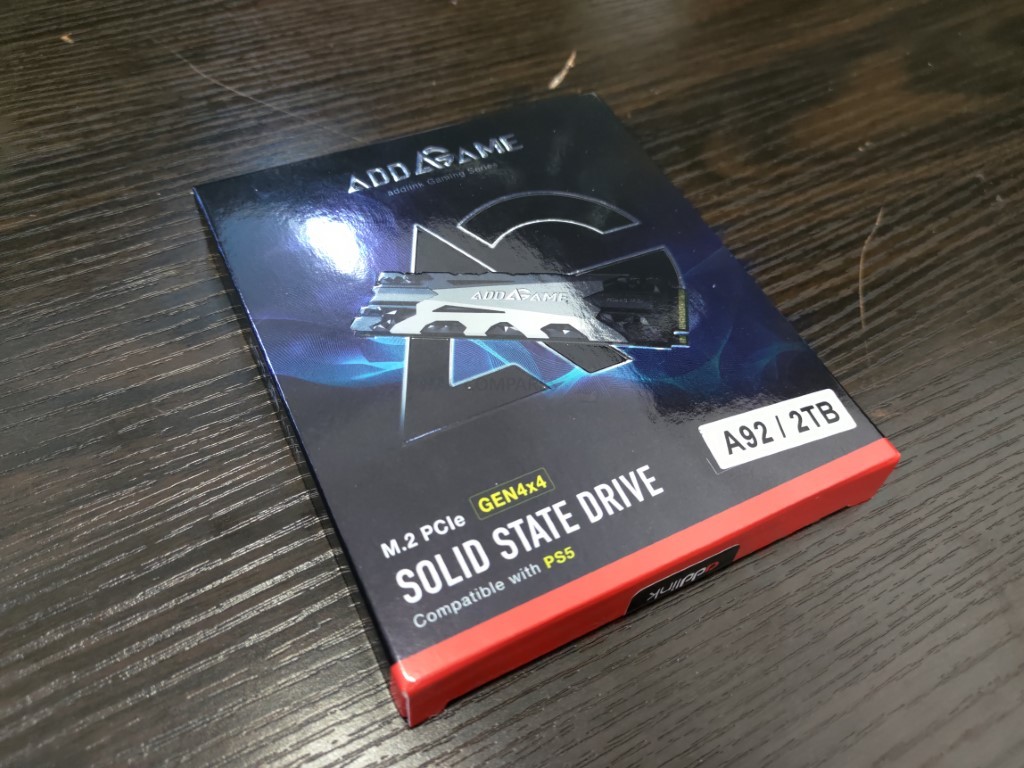
The rear of the box makes a point of not only highlighting that this SSD is PS5 compatible, but also it’s one of the first SSDs I have had in for review that actually features the official PS5 logo. Along with that, there is a little nod to the heatsink and rather unique (at least as far as other M.2 SSDs on the market) application of the heatsink, using a much more malleable substance (we will go into more detail later) they are keen to highlight that this does an improved job of maintaining the SSD temperature. This will be covered at the last 3rd of this review in the testing and benchmarking.
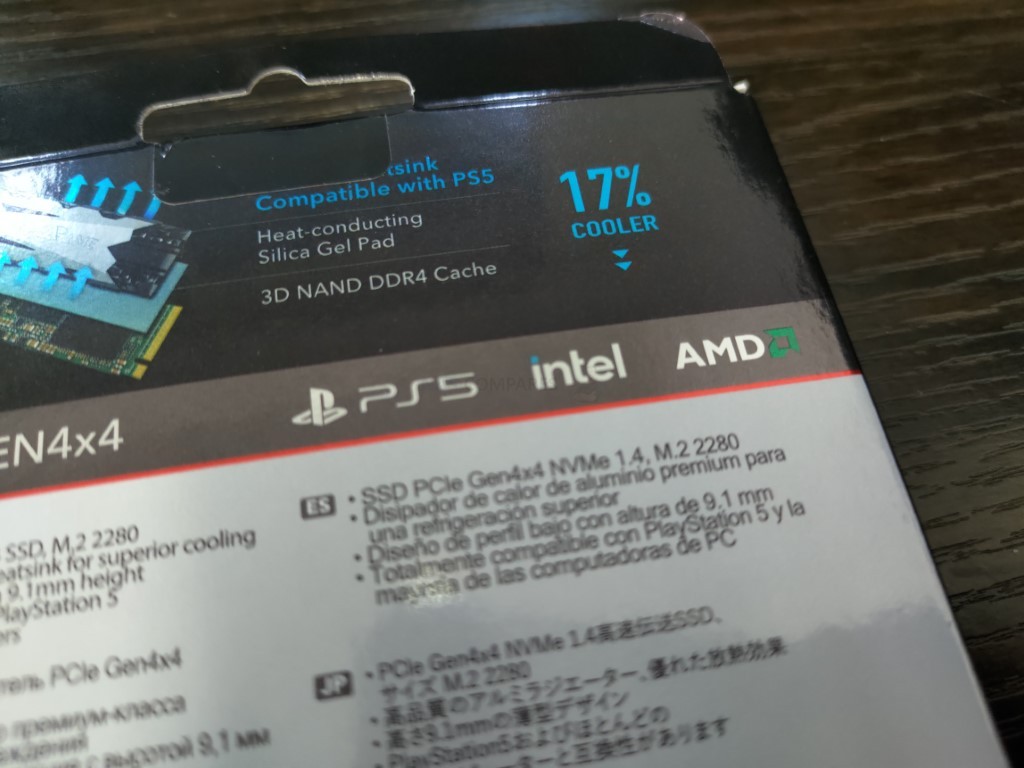
The contents of the box are a little small, but not in a bad way. A first-time setup guide and warranty information is included in a booklet (as well as the usual web/3D-Barcode links), as well as the SSD itself (with heating pre-applied).
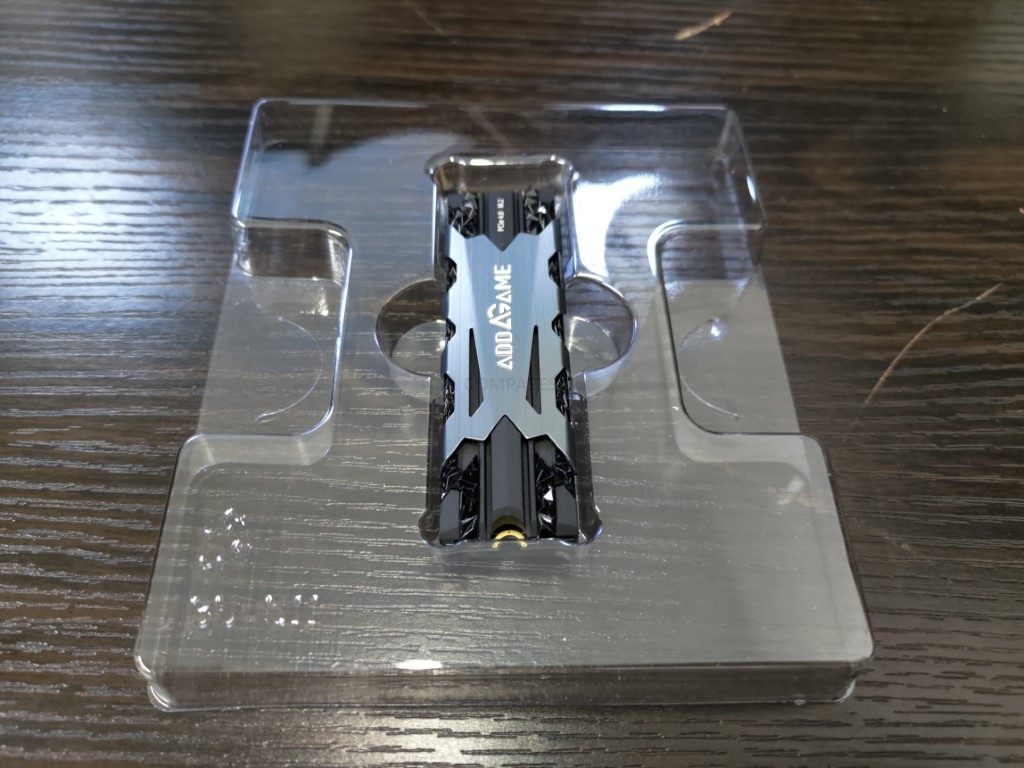
The Heatsink on the Addlink A92 is an interesting mix of elements that include aesthetical design, air efficiency and professional application. Addlink have an impressive range of m.2 NVMe solutions in their catalogue, many using modified versions of this heatsink (depending on the product series), so the need to add the Add AGame logo and PCIe4.0 architecture makes sense.
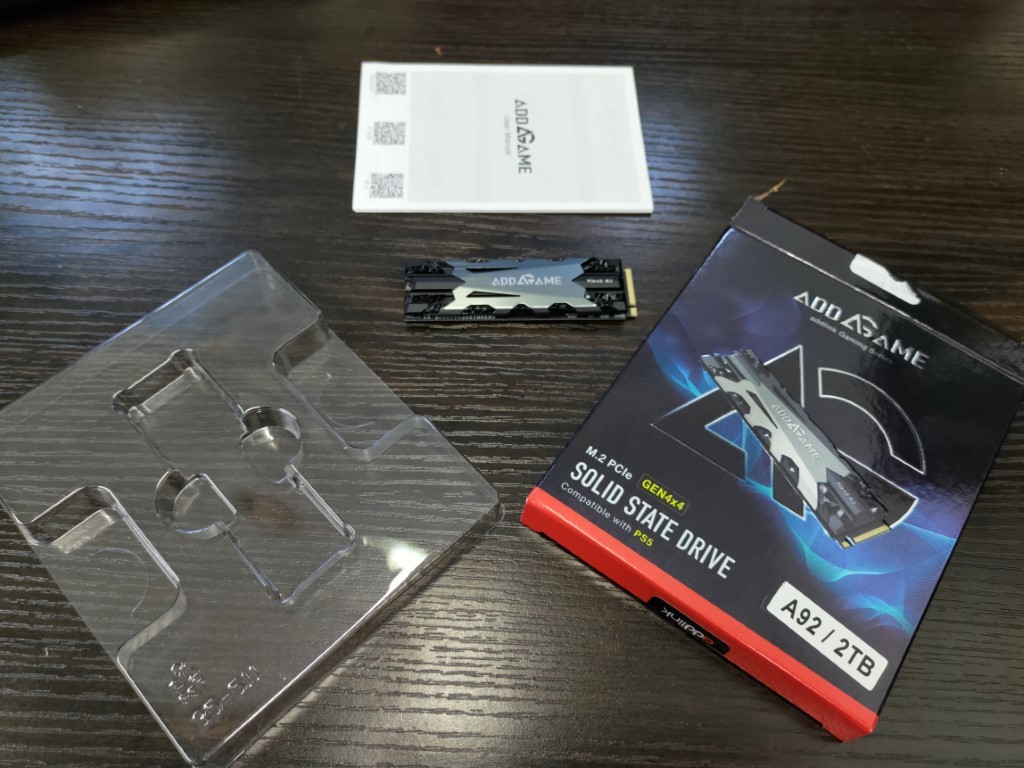
Looking at the A92 heatsink directly, it is a sweet looking design. Comprised of 3 main elements, a pre-cute metal plate with air channel grooves, a secondary metal clip that surrounds it and finally the thermal silica gel pad that connected the Heatsink to the SSD.
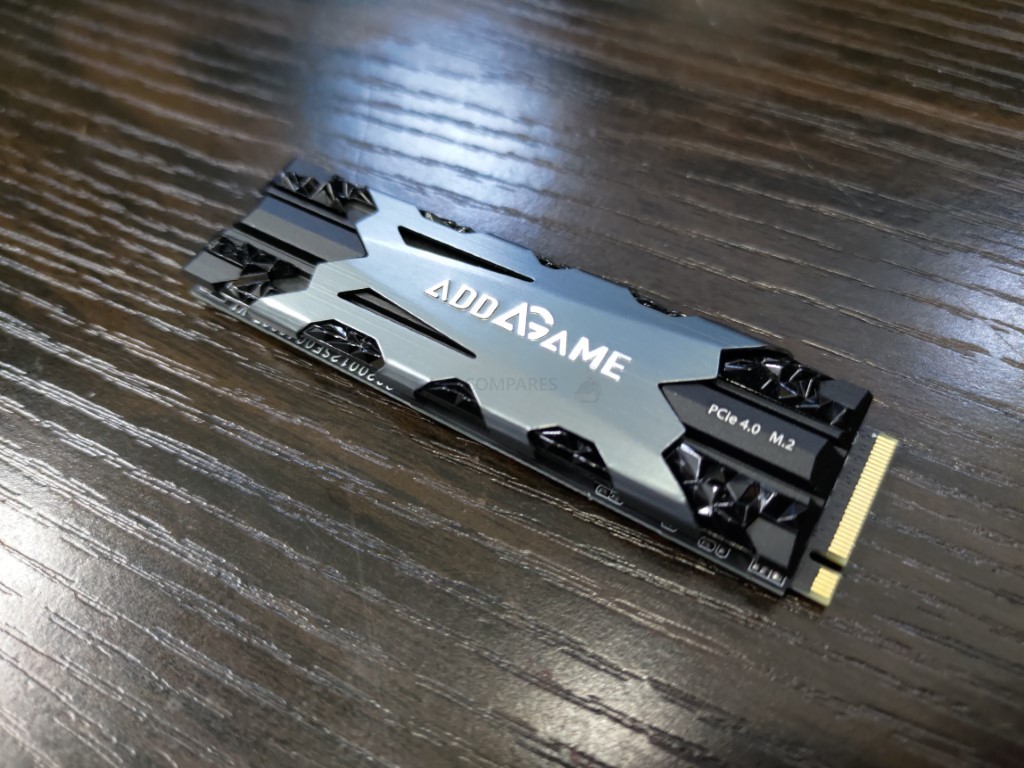
Looking at the Addlink A92 at an angle shows that, despite the aggressive nature of the heatsink, it is actually not very tall. In fact, the Low-Profile designed heatsink is only has a 9.1 mm height, with the total Heatsink+silica+SSD coming to just under 11.25mm. With space being at a premium in the PS5 M.2 SSD slot (and users wanting a little space around/above their SSD+HS to promote any airflow, this is particularly impressive.
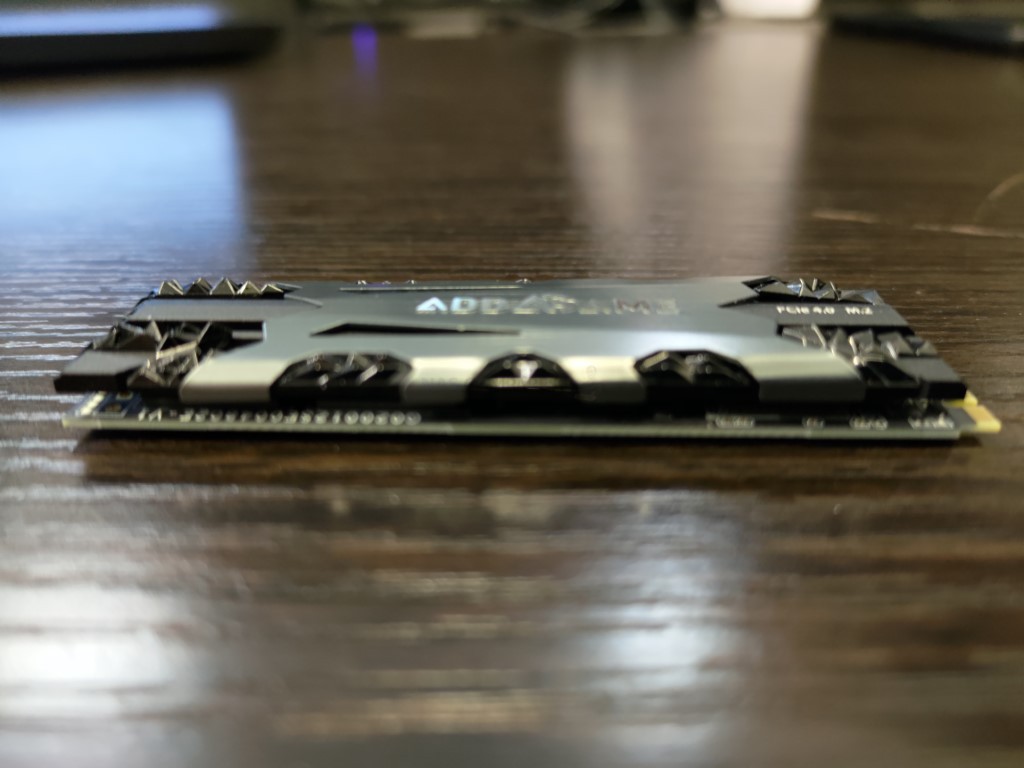
Likewise, the heatsink is fractionally raised from the SSD a degree higher than most SSD+HS combos on the Adddlink A92, as the silica gel between them is particularly thick and envelopes the chips underneath a tad (on purpose). This means that is a surrounding around that can capture passing airflow around the SSD, that is not obstructed by a surrounding casing.
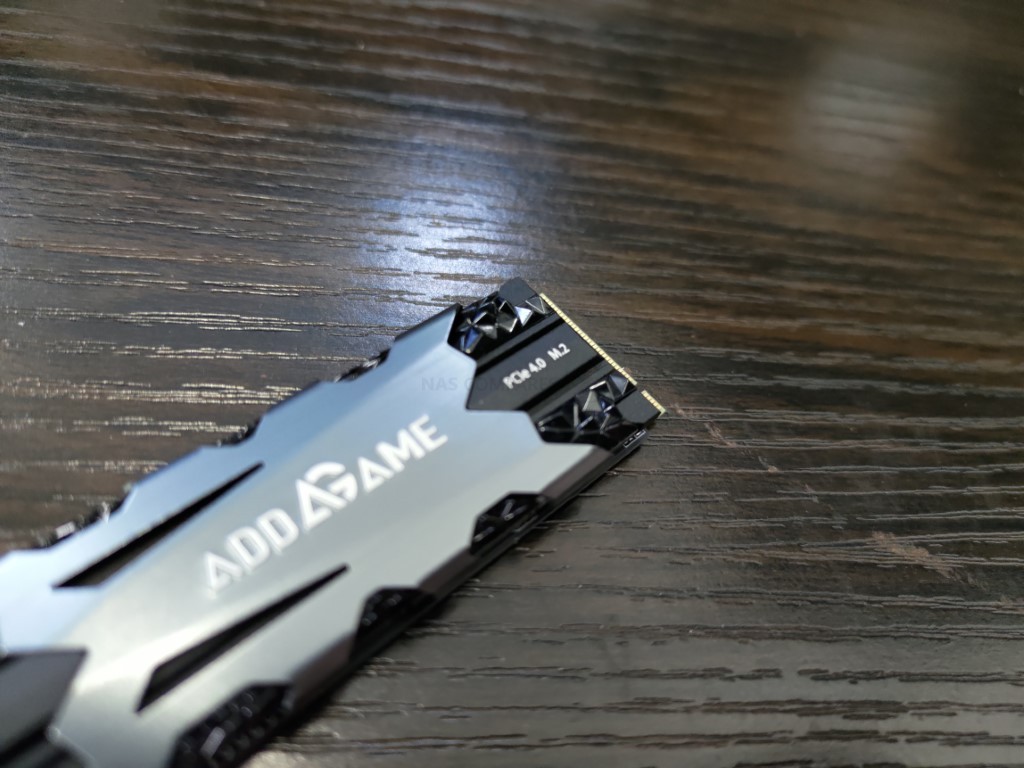
Removing the Addlink A92 Heatsink was NOT easy. I cannot stress enough how well attached this heatsink was! I nearly snapped the SSD in two trying to remove it. The SSD uses an adhesive coated silica gel that covered the entirety of the M.2 NVMe SSD, but also slightly envelopes each chip on the drive. It doesn’t smother them (so no touching the PCB) but it does surround the edges of each component to cover a greater physical density, whilst still remaining tidy.
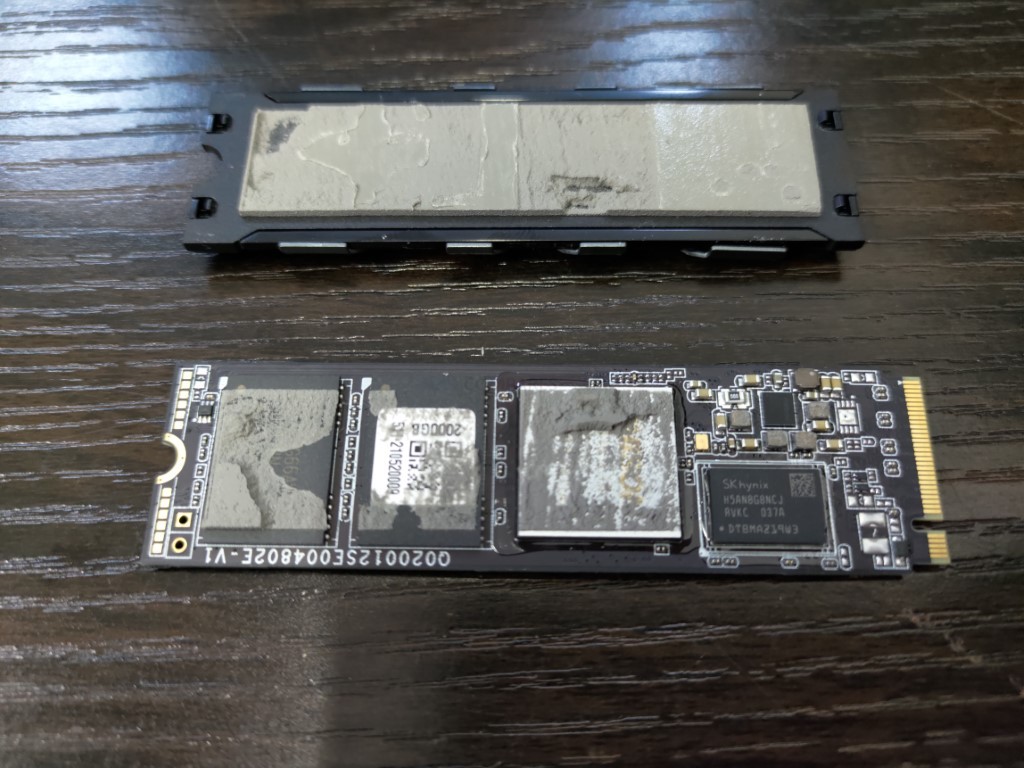
A closer look a the heatsink base shows you just how well it surrounds each chip (with clear indications of where each was placed from imprints). Additionally, you can see that the consistency of the silica gel pad is not the same as the reusable pads in other heatsinks, with this substance having more in common with thermal paste found on CPUs. The slightly porous nature of it definitely seemed to ensure that the components were adequately covered and it does leave you with a distinct feeling of quality and professional application.
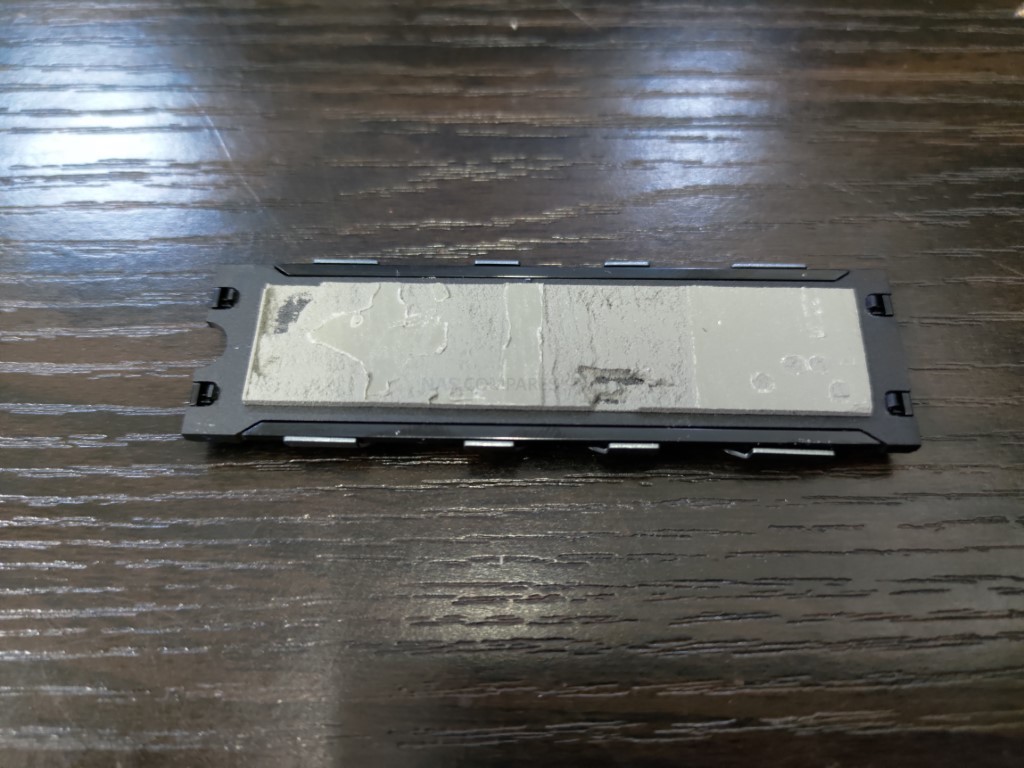
Taking the time to clean a little of the silica gel away, you can see that the A92’s controller is much lower on the board than many other SSDs (where it will more often be located directly beneath the m.2 key connector.
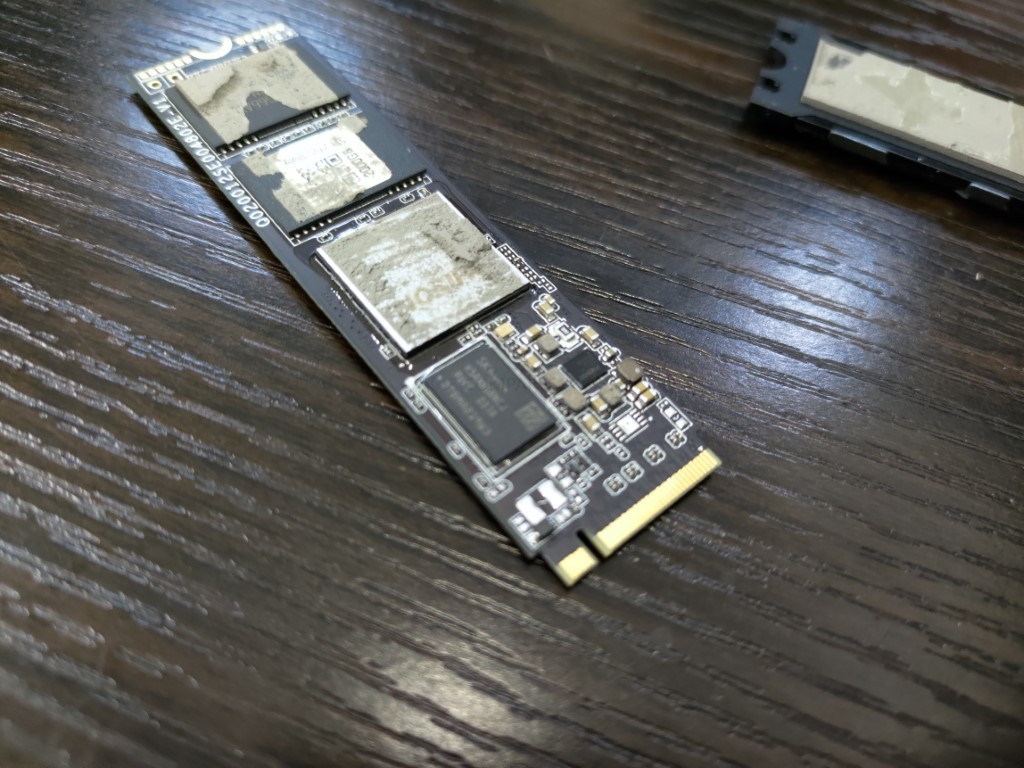
As mentioned, the Addlink A92 NVMe SSD fits very neatly into the PS5 SSD upgrade slot, with a clear few millimetres between the heatsink and the m.2 slot cover. Although it is worth highlighting that this heatsink was originally designed for a gaming desktop PC installation (like 99% of other M.2 SD heatsinks), so I will hold full judgement on how efficient the A92 heatsink is for PS5 heat dissipation for another article/video soon.
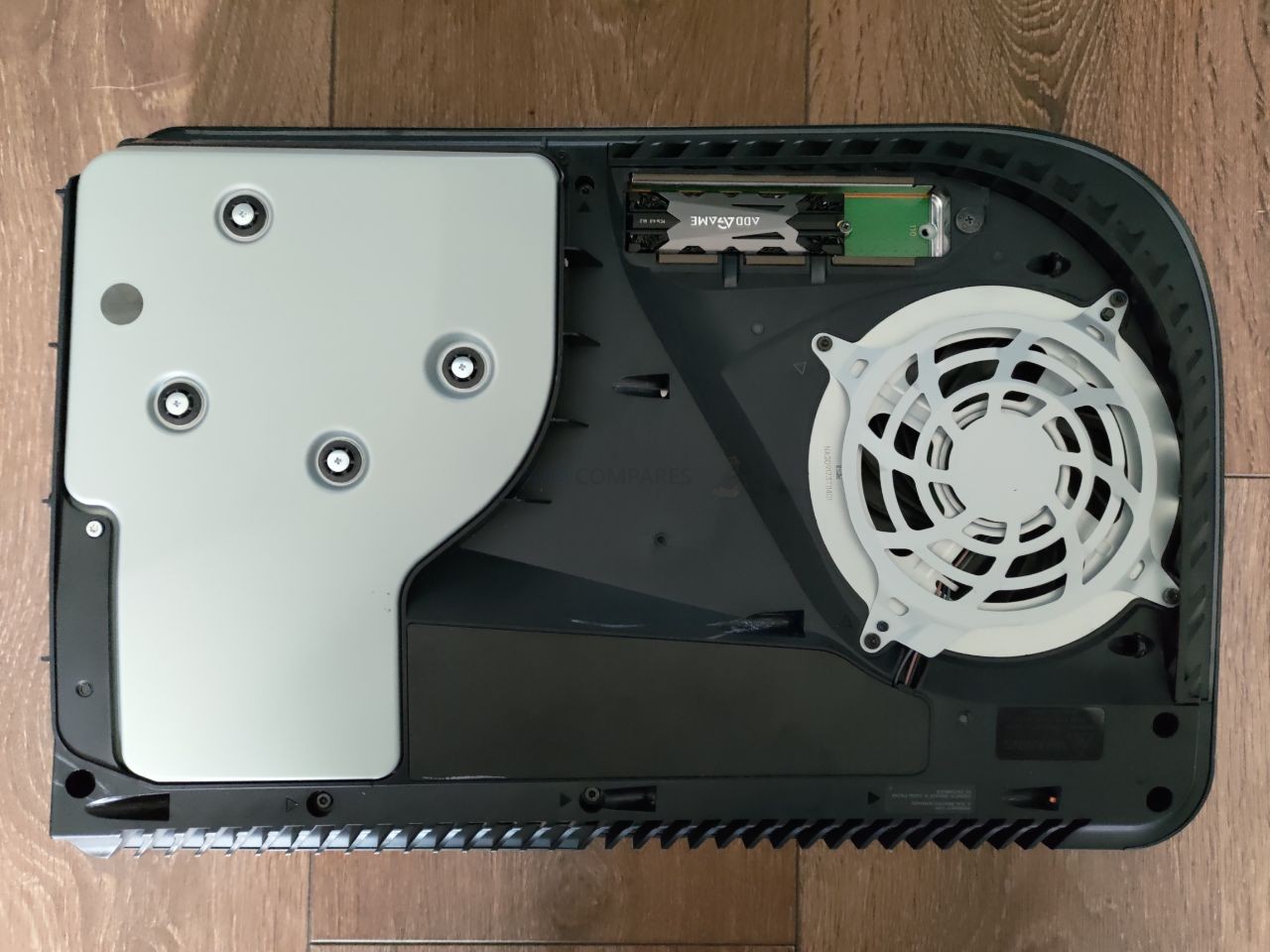
So that is the physical design of the Addlink A92 SSD. But what about the hardware components themselves? Does the Addlink A92 cut the mustard in terms of current generation hardware and protocols? Let’s find out.
Addlink A92 SSD Review – PS5 Benchmark
Upon installing the Addlink A92 SSD into the PS5, the system gave an impressive benchmark of 5620MB/s. It should be noted that the PS5 has a very unique benchmarking system internally for its own software needs and although Sony recommends that you only use SSDs with a reported 5,500MB/s+ performance (sequential Read) minimum, we have seen SSDs with a lower reported PC benchmark of this be rated at 5,500MB/s+ om the PS5 benchmark. So, there is definitely wiggle room there.
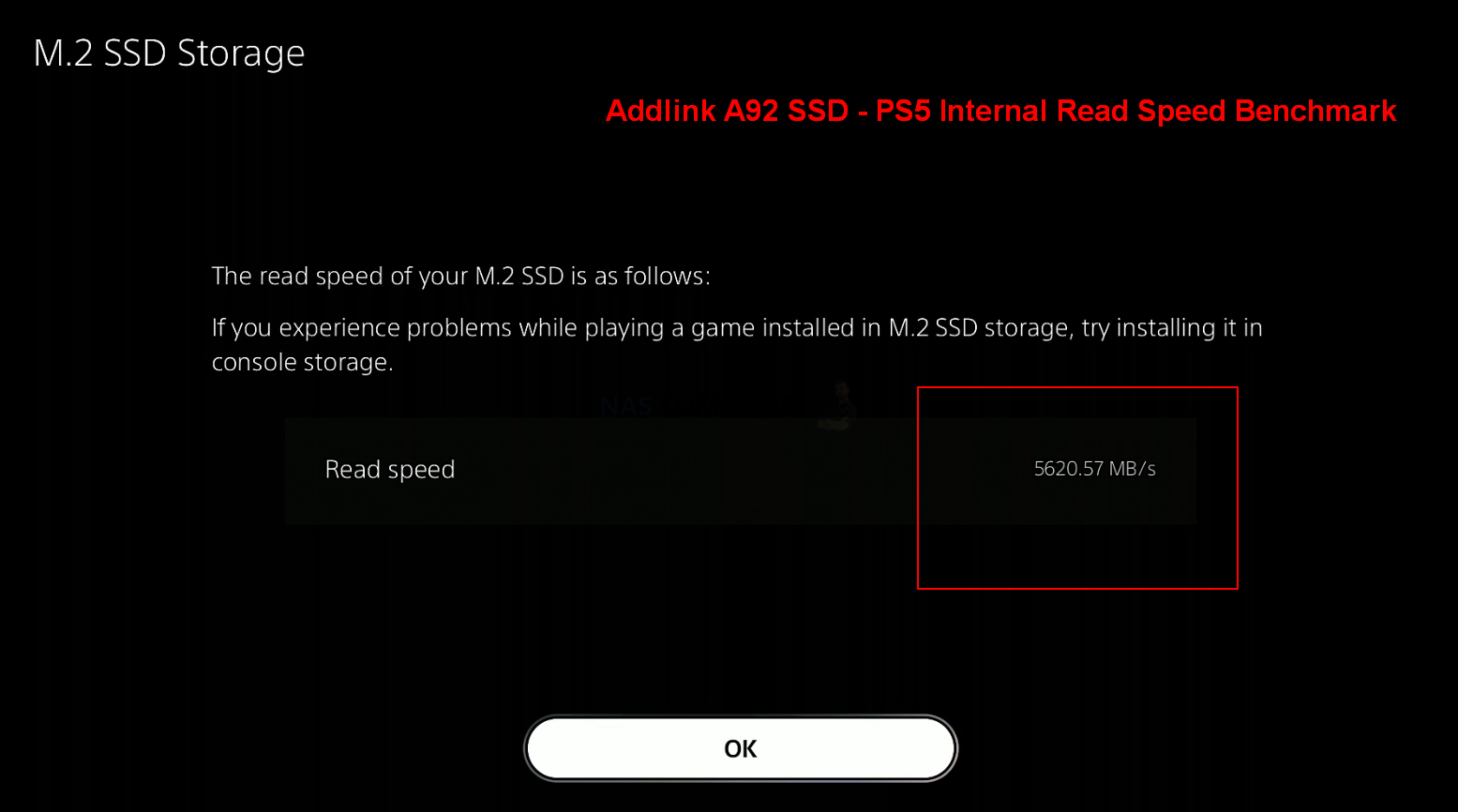
To put the Addlink A92 SSD PS5 Performance Benchmark into a little perspective, here is how it compares against the Sabrent Rocket Q4, as these SSDs that are both PS5 supported and VERY similar architecture:
 |
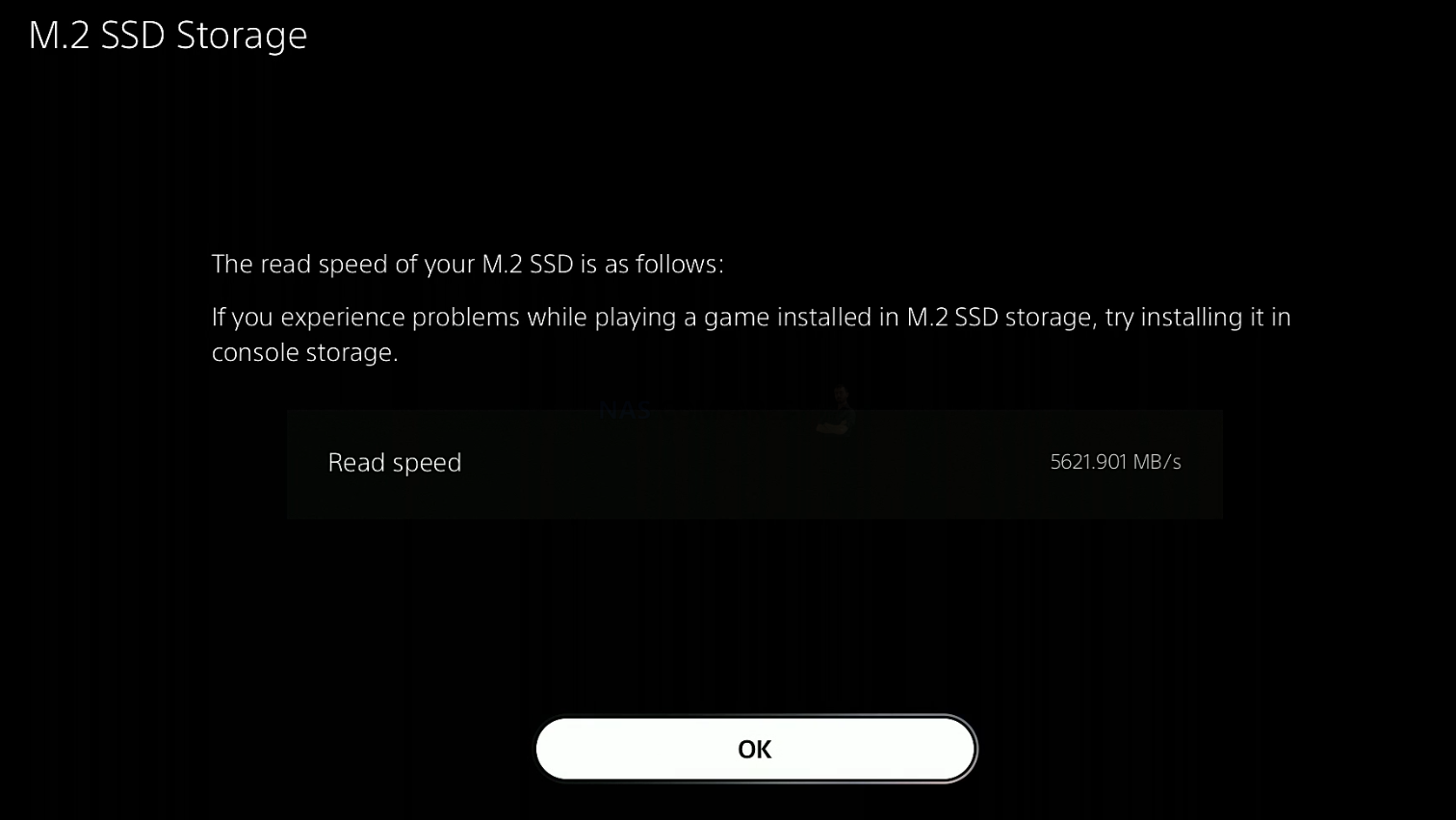 |
| Addlink A92 PS5 Benchmark – 5620MB/s | Sabrent Rocket Q4 PS5 Benchmark – 5621MB/s |
With very little difference between the top three others in this tier, it is a solid benchmark. Additionally, the Addlink A92 takes care of overprovisioning at the NAND/Controller level (with four 96L QLC NAND modules of 512GB), so that means that this 2TB SSD is genuinely available as 2TB on the Playstation 5 Storage manager (not 1,920GB as seen previously):
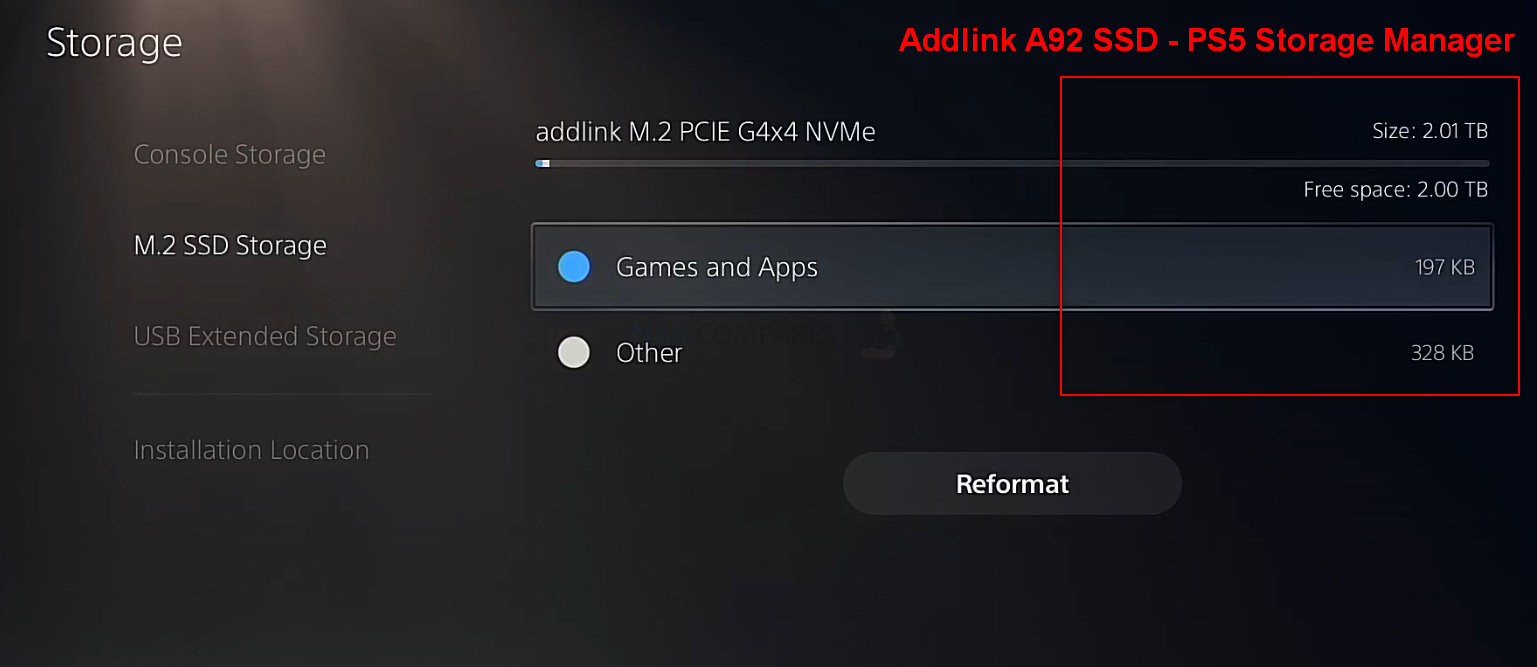
Full PS5 Testing of the Addlink A92 (along with the A90 and A95) are available HERE on the NASCompares YouTube channel. But for now, let’s carry on with looking at the hardware of the A92, how it conventionally benchmarks and how it compares with currently favourite QLC NAND SSD, the Sabrent Rocket Q4.
Addlink A92 SSD Review – Hardware Specifications
The first thing to look at is the architecture of this SSD. Later we will compare it against a very similar built SSD, the sabrnet Rockeet QLC, but for now, here is how the SSD SSD is built:
| Addlink A92
1TB – $139/£115 – 2TB – $267/£249 4TB – $539 / £499 |
|
| PCIe Generation | PCIe Gen 4 |
| NVMe Rev | NVMe 1.3 |
| NAND | QLC KIOXIA 96L |
| Max Capacity | 4TB – Double Sided |
| Controller | Phison E16-PS5016 |
| Warranty | 5yr |
I know a lot of the above will seem needlessly technical, so below we can bring the most important considerations into sharper focus.
Hardware Focus of the Addlink A92 SSD Series
The first big, BIG thing to remember here is the controller, that Phison E16. An SSD is much like a microcosm version of a whole computer. The Controller is equivalent to the CPU, and Phison are one of the bigger 3rd party SSD controller manufacturers in the world! I say 3rd party, because some long-running storage brands like Samsung and WD have most of their development and hardware engineering ‘in-house’ and use their own branded controllers. Whereas some brands source some/all components for their SSDs from 3rd parties – which is not necessarily a bad thing for both them and the industry (there are pros and cons on either side). Phison has been at the cutting edge of this subject for years now and the newer E18 was first revealed last year in 2020, but due to the pandemic making storage trends unpredictable and semi-conductor shortages, most SSDs that utilized the Phison E18 eventually arrived in 2021. Before that though was the Phison E16, the brands first PCIe 4.0 controller for NVMe SSD and it was widely featured by SSD brands at launch. This controller is one of the biggest reasons that the Addlink A92 can actually back up its promises about the 5,00MB/s+ Sequential Read (sequential data = big chunks of data). However, that is not the only reason.
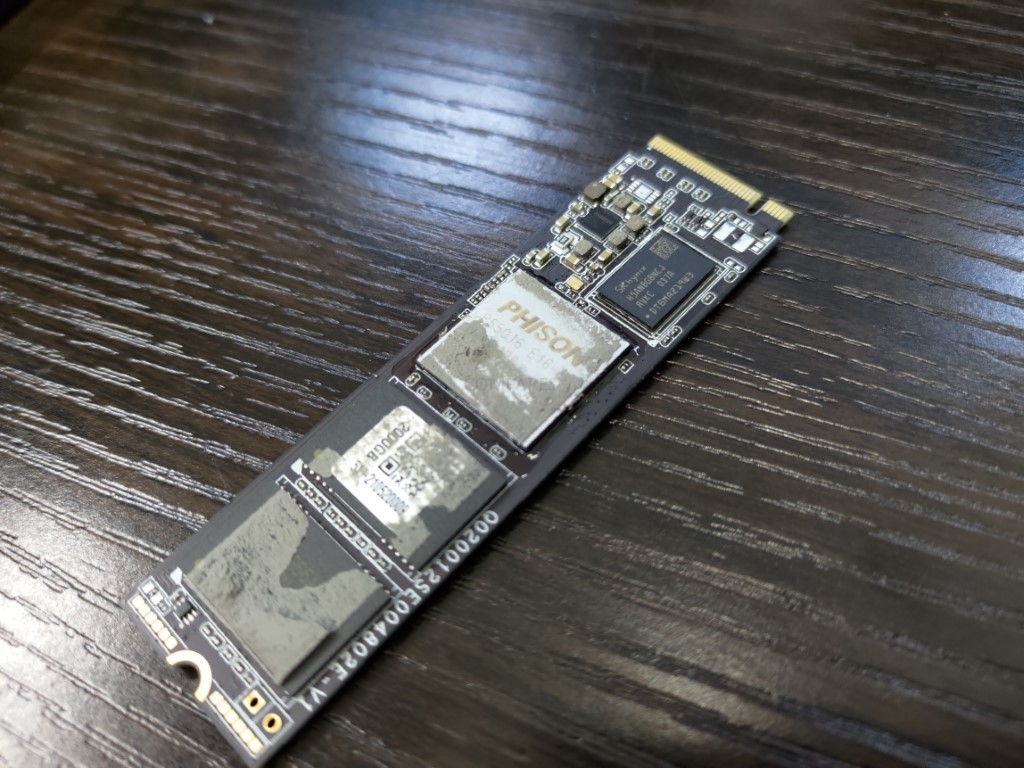
The NAND on the Addlink A92 is where the data lives! SSDs (as you no doubt know) do not use moving parts as found in traditional hard drives and instead uses cells that are charged and data is read/written to them in this process. The quality of the NAND and the layers used will make a big difference to the durability and performance. The Addlink A92 and it’s Phison 16 arrive with 96 layer 3D QLC NAND onboard but it’s pairing with QLC NAND (not the more common but arguably more expensive TLC NAND) but does feature it at 96L, which is on par with more current-gen PCIe 4 M.2 SSDs in the market.
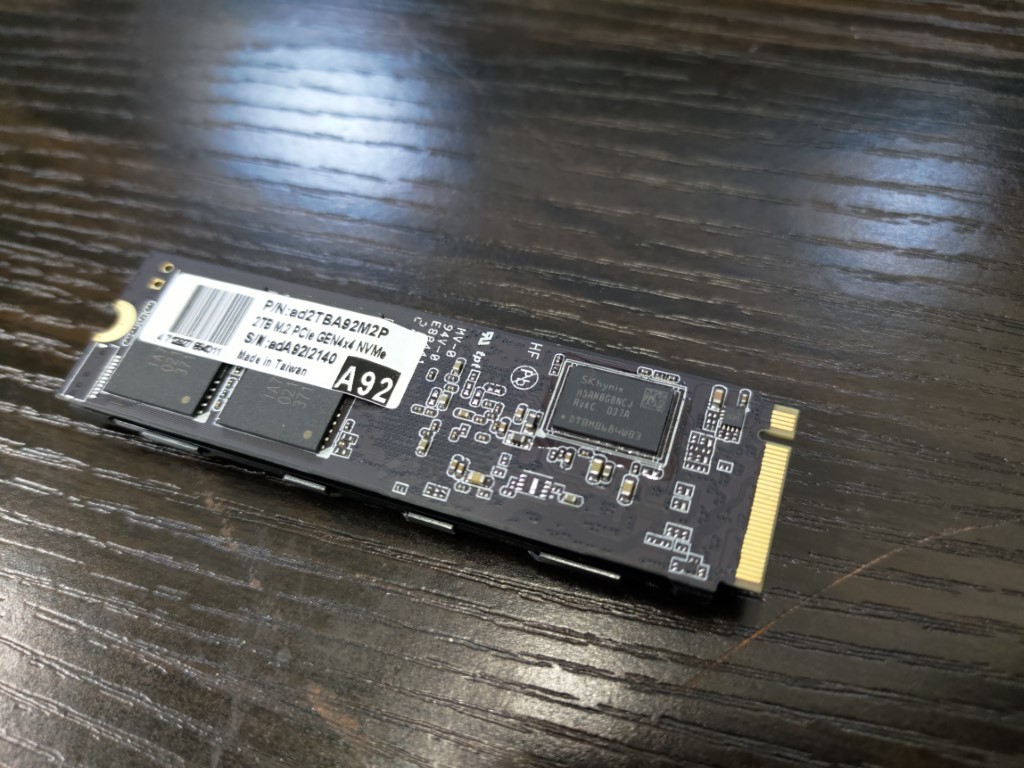
Much like the Controller on the Addlink A92 being the ‘CPU’, it also has an area of memory. The Addlink A92 SSD uses DDR4 memory on board and this in conjunction with the SSD provides a massive body of data handling resources for getting your data moving through the SSD and out of the m.2 NVMe PCIe 4 interface. The amount of memory scales in conjunction with the 1TB or 2TB SSD you use, with 2GB of DDR4 at the on the 2TB tier, 1GB DDR4 on the 1TB, etc.
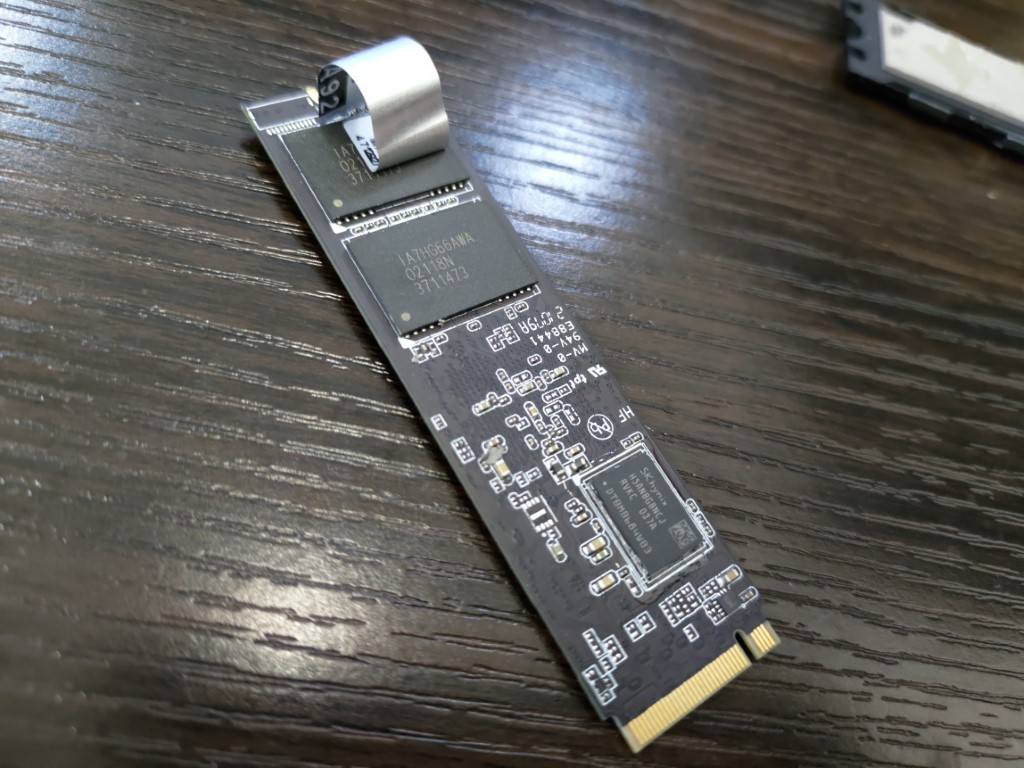
Finally, there is the M.2 NVMe connection. Not all m.2 SSDs are created equal and although M.2 SATA and M.2 NVMe look similar, they provide massively different performance and connectivity. However, the Addlink A92 takes it one step further, by using a newer generation of PCIe Connectivity. In short, M.2 NVMe SSDs are connected to the host PC/Console system via PCIe protocol (think of those slots that you almost always use for your graphics cards, but a much, MUCH smaller connector). These allow much larger bandwidth (ie maximum speed) for the connected storage media, Much like regular PCIe slots, they have different versions (i.E PCIe Gen 1, 2, 3, 4, etc) and also a multiplying factor (x1, x2, x4, etc). Up until around 18 months ago, the best M.2 NVMes were M.2 PCIe Gen 3×4 (so a maximum 4,000MB/s possible). However, never generation SSD like the Addlink A92 use PCIe Gen 4×4 (a potential 8,000MB/s possible) and it is only now that SSD controllers and NAND production has reached a point where it can catch up and fully saturate (i.e fill) this connection.
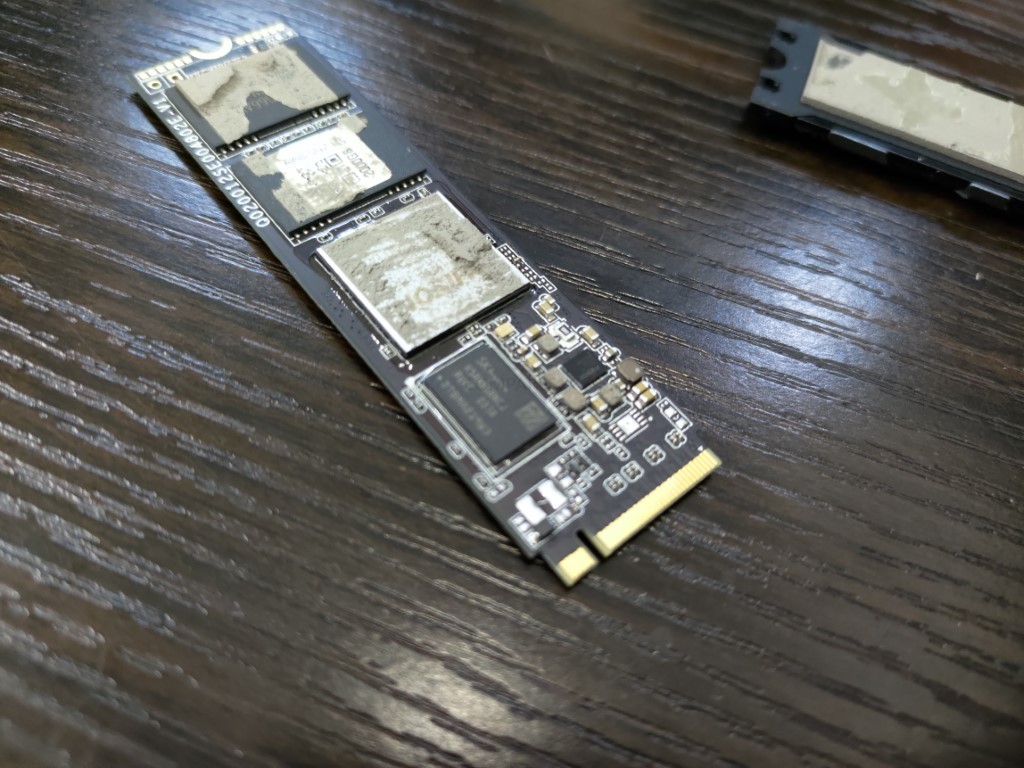
Overall, you really cannot fault the hardware inside/onboard the Addlink A92 (apparent from querying that NAND), as it is still (at release) higher performing in sequential Read and Write than many other M.2 NVMe SSDs in the market at both QLC use AND those at PCIe Gen 3. Before we go into the full testing, however, it is worth taking a moment to look closely at the reported performance benchmarks of the Addlink A92, as although the performance seems stellar, there are areas such as IOPS and endurance when compared with its main rivals that are worth taking into consideration.
Addlink A92 SSD Review – Official Stats First
Before we conduct our own testing on this SSD, Let’s take a closer look at the reported specifications and benchmarks first. The Addlink A92 SSD arrives in multiple capacities (below), although rather odd that there is no 8TB version, given the space increases that QLC SSDs allow and some brands able to squeeze 8TB on a 2280 SSD at QLC level. The Prices currently are a little inconsistent (with each higher capacity tier actually having a higher price per GB – quite unusual) likely due to the hardware shortages, the Pandemic, Chia has affected SSD availability in the last 12 months and most recently the announcement that PS5 supports this SSD and it has increased the majority of PS5 supported SSDs price point in most regions. Below is a breakdown of how each Addlink A92 SSD compares against its closest competitor, the Sabrent Rocket Q4:
| Brand/Series | Addlink A92
1TB – $139/£115 – 2TB – $267/£249 4TB – $539 / £499 |
Sabrent Rocket Q4
|
| PCIe Generation | PCIe Gen 4 | PCIe Gen 4 |
| NVMe Rev | NVMe 1.3 | NVMe 1.3 |
| NAND | QLC KIOXIA 96L | QLC Micron 96L |
| Max Capacity | 2TB – Double Sided | 4TB – Single Sided |
| Controller | Phison E16-PS5016 | Phison E16-PS5016 |
| Warranty | 5yr | 1yr/5yr |
| 500GB Model | N/A | N/A |
| Price in $ and $ | N/A | N/A |
| 1TB Model | AD1TBA92M2P | SB-RKTQ4-1TB |
| Price in $ and $ | $139 / £135 | $159 / £140 |
| 2TB Model | AD2TBA92M2P | SB-RKTQ4-2TB |
| Price in $ and $ | $267 / £249 | $319 / £285 |
| 4TB Model | AD4TBA92M2P | SB-RKTQ4-4TB |
| Price in $ and $ | $539 / £499 | $749 / £605 |
| 500GB Model | N/A | N/A |
| Total Terabytes Written (TBW) | N/A | N/A |
| Mean Time Between Failures (MTBF, hours) | N/A | N/A |
| DWPD | N/A | N/A |
| 1TB Model | AD1TBA92M2P | SB-RKTQ4-1TB |
| Total Terabytes Written (TBW) | 200TB | 200TB |
| Mean Time Between Failures (MTBF, hours) | N/A | 1,800,000 |
| DWPD | 0.1DWPD | 0.1DWPD |
| 2TB Model | AD2TBA92M2P | SB-RKTQ4-2TB |
| Total Terabytes Written (TBW) | 400TB | 400TB |
| Mean Time Between Failures (MTBF, hours) | N/A | 1,800,000 |
| DWPD | 0.1DWPD | 0.1DWPD |
| 4TB Model | AD4TBA92M2P | SB-RKTQ4-4TB |
| Total Terabytes Written (TBW) | 800TB | 800TB |
| Mean Time Between Failures (MTBF, hours) | N/A | 1,800,000 |
| DWPD | 0.1DWPD | 0.1DWPD |
There are clear throughput improvements as you rise through the capacity tiers (not unusual), as does the rated 4K IOPS. Though one area worth focusing on a little is that TBW (terabytes Written) and DWPD (Drive writes per day), as the expected massive drop in durability (chiefly focused on daily/annual write activity) is massive compared with other higher tier SSDs in the market, allow on par with the Sabrent Rocket Q4. s mentioned, although the durability of an SSD is incredibly important, the PS5 (and indeed PC gaming outside of streaming and recording/capture) is an INCREDIBLY heavy READ activity, so although durability is important still, the drop to 0.1 Drive Write per day (when compared against the 0.4 and 0.9 DWPD of the A95 and A90) is not as make-or-break as it might have been elsewhere.
As you might expect from the use of the Phison E16 controller and 96 layer NAND, the reported IOPS on each capacity is actually pretty similar to the 96L Sabrent Rocket Q4. This is still very impressive anyway (if compared against older-gen SSDs and not prosumer class drives). As aside from the NAND on the A92, the rest of the architecture of the drive is actually very similar indeed to the Firecuda 520, Sabrent Rocket PCIe 4.0 and Silcon Power US70 – with write performance vs those TLC NAND SSDs almost half in some places (getting considerably worse at the lower capacities). Below is the read and write of the Addlink A92 vs the Sabrent Rocket Q4, along with reported IOPS:
| Brand/Series | Addlink A92
1TB – $139/£115 – 2TB – $267/£249 4TB – $539 / £499 |
Sabrent Rocket Q4
|
| 500GB Model | N/A | N/A |
| Sequential Read (Max, MB/s), 128 KB | N/A | N/A |
| Sequential Write (Max, MB/s), 128 KB | N/A | N/A |
| 1TB Model | AD1TBA92M2P | SB-RKTQ4-1TB |
| Sequential Read (Max, MB/s), 128 KB | 4700MB | 4700MB |
| Sequential Write (Max, MB/s), 128 KB | 1850MB | 1850MB |
| 2TB Model | AD2TBA92M2P | SB-RKTQ4-2TB |
| Sequential Read (Max, MB/s), 128 KB | 4850MB | 4800MB |
| Sequential Write (Max, MB/s), 128 KB | 3600MB | 3600MB |
| 4TB Model | AD4TBA92M2P | SB-RKTQ4-4TB |
| Sequential Read (Max, MB/s), 128 KB | 4900MB | 4900MB |
| Sequential Write (Max, MB/s), 128 KB | 3600MB | 3500MB |
| Brand/Series | Addlink A92 | Sabrent Rocket Q4 |
| 500GB Model | N/A | N/A |
| Random Read (Max, IOPS), 4 KB QD32 | N/A | N/A |
| Random Write (Max, IOPS), 4 KB QD32 | N/A | N/A |
| 1TB Model | AD1TBA92M2P | SB-RKTQ4-1TB |
| Random Read (Max, IOPS), 4 KB QD32 | 180,000 | 180,000 |
| Random Write (Max, IOPS), 4 KB QD32 | 450,000 | 450,000 |
| 2TB Model | AD2TBA92M2P | SB-RKTQ4-2TB |
| Random Read (Max, IOPS), 4 KB QD32 | 350000 | 350000 |
| Random Write (Max, IOPS), 4 KB QD32 | 700,000 | 700000 |
| 4TB Model | AD4TBA92M2P | SB-RKTQ4-4TB |
| Random Read (Max, IOPS), 4 KB QD32 | 350000 | 350,000 |
| Random Write (Max, IOPS), 4 KB QD32 | 700000 | 700,000 |
So incredibly similar! There are a few slithers of difference here, but given the 10% or so price decrease in the Addlink A92 (as well as the fact it includes a premium heatsink), it does make that drive look the better choice of the two. That said, both SSDs (on paper at this stage!) are fantastic examples of where consumer and prosumer SSDs are evolving towards. Let’s get the Addlink A92 on the test machine!
Testing the Addlink A92 m.2 PCIE4 NVMe SSD
The Addlink A92 was selected for this test and it was tested using multiple benchmark tools, from a cold boot, in the 2nd storage slot (i.e not the OS drive). Each test was conducted three times (full details of this are shown in the YouTube Review of the Addlink A92 over on NASCompares):
Test Machine:
- Windows 10 Pro Desktop System
- Intel i5 11400 Rocket Lake – 6-Core 2.6/4.4Ghz
- 16GB DDR4 2666MHz Memory
- Intel B560M mATX Motherboard
- OS Storage, Seagate Firecuda 120 SSD
- Test SSD connected to Secondary PCIe Gen 4 M.2 Slot
Using CrystalDisk, we got a good measure of the drive and verified that this PCIe Gen 4 x4 SSD was indeed using the 4×4 lane. Additionally, the temp averaged out around 41C between each test being conducted.
CRYSTAL DISK BENCHAMRK
The first tests were conducted using the ATTO disk benchmark software. The first was a 256MB test file size and below is a breakdown of the transfer rates and IOPS. The 2nd Test was a 1GB test file and finally, the last test was with a 4GB test file. The system was given 1-minute cool downtime between tests, no screen recording software was used (remove overhead) and a heatsink was used throughout (no reboots)
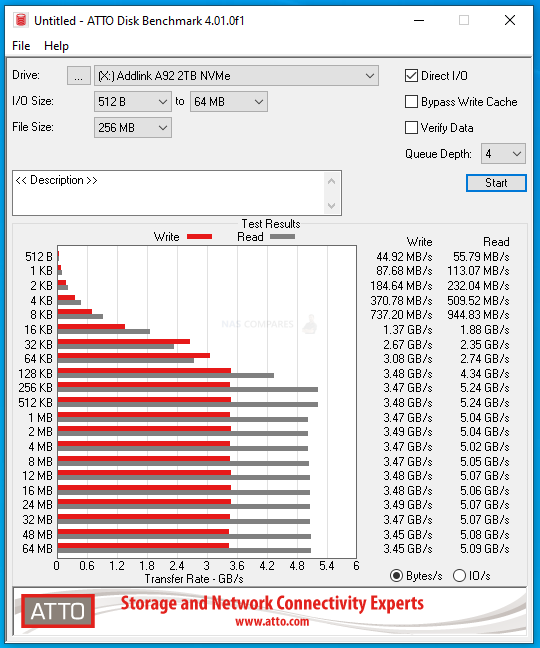 |
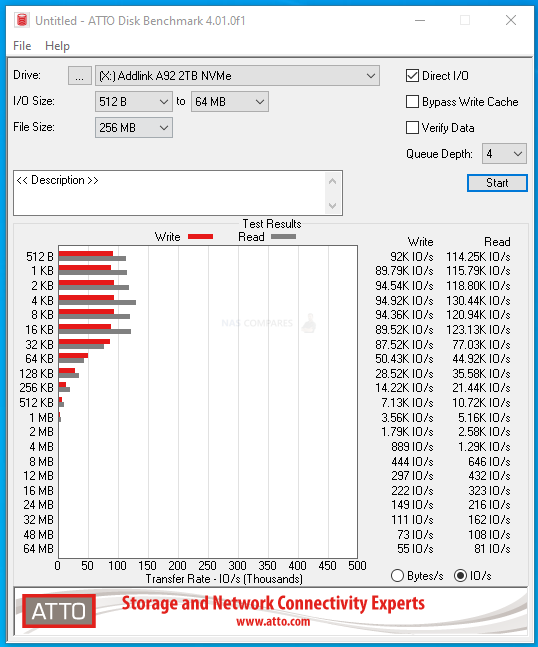 |
ATTO Disk Benchmark Test #1
256MB File PEAK Read Throughput = 5.24GB/s
256MB File PEAK Write Throughput = 3.49GB/s
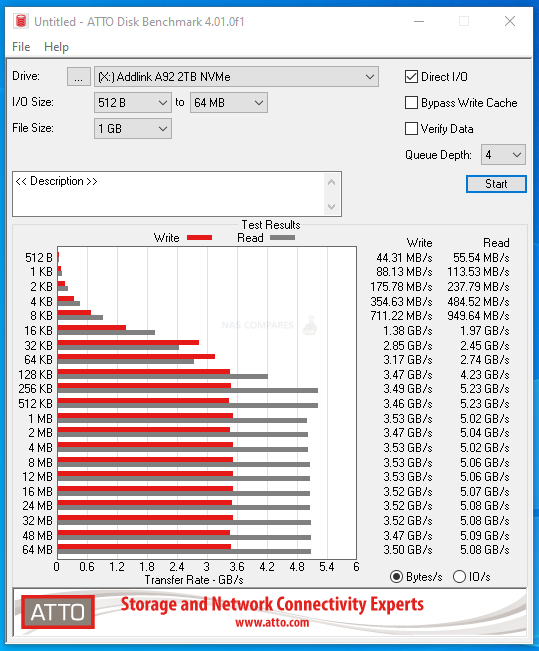 |
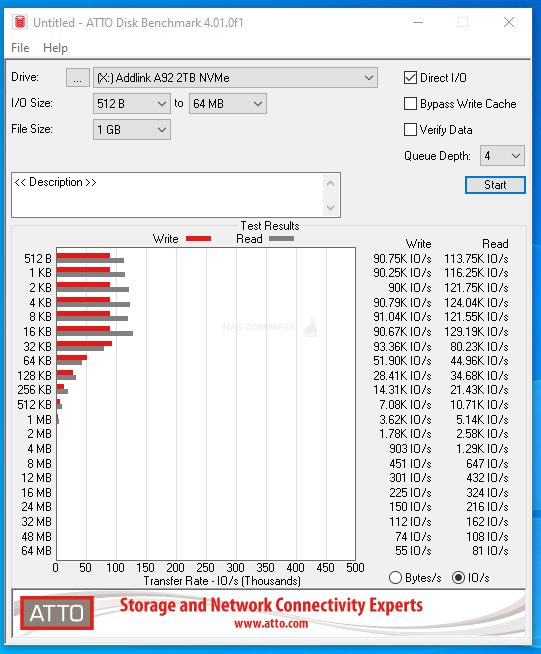 |
ATTO Disk Benchmark Test #2
1GB File PEAK Read Throughput = 5.23GB/s
1GB File PEAK Write Throughput = 3.53GB/s
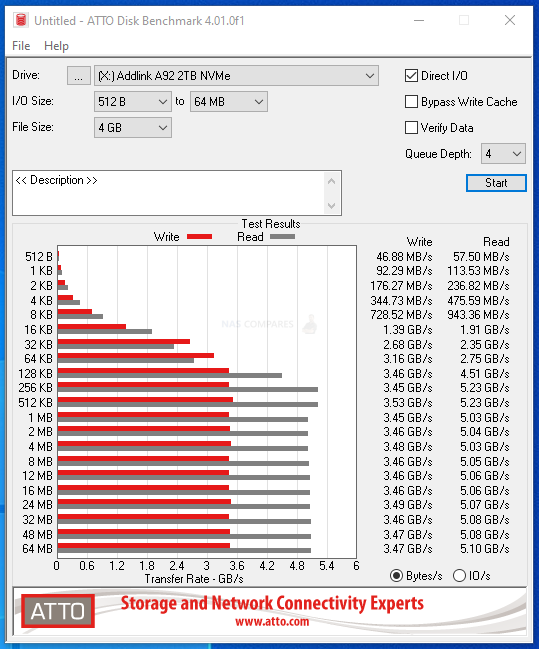 |
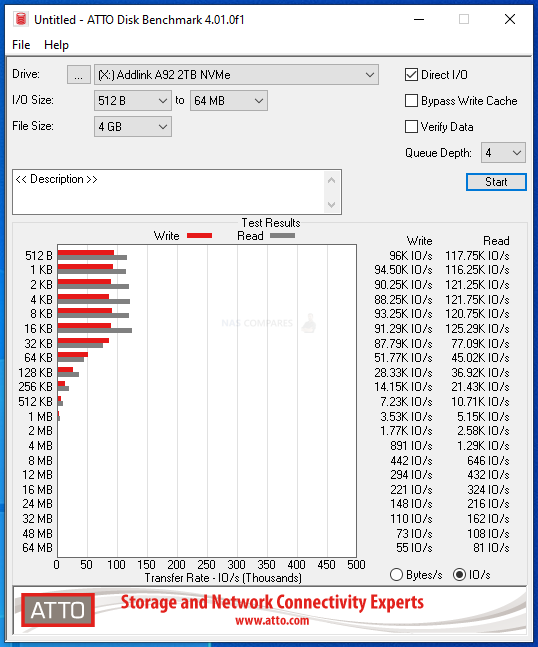 |
ATTO Disk Benchmark Test #3
4GB File PEAK Read Throughput = 5.23GB/s
4GB File PEAK Write Throughput = 3.53GB/s
Next, although the ATTO tests were quite good, but not what I would have hoped from this SSD, so I moved on to the Crystal Disk Mark testing to see how well it would handle our lasts barrage of tests. The first test was the 1GB file testing, which measured both sequential and random, as well as the read and write IOPS. Test were conducted on a 1GB, 4GB and 16GB Test File. I also included a mixed 70/30 read and write task to give a little bit more of a realistic balanced workload. These tests were conducted with 1-minute cooling break in between
CRYSTALDISK MARK 1GB TEST
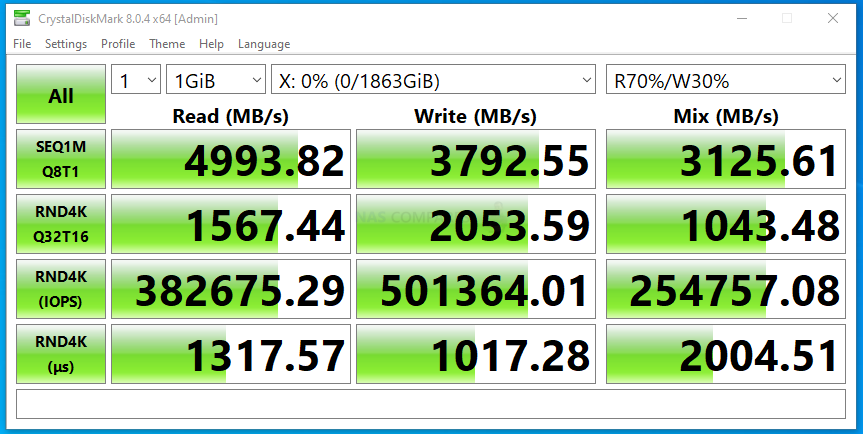
CRYSTALDISK MARK 4GB TEST
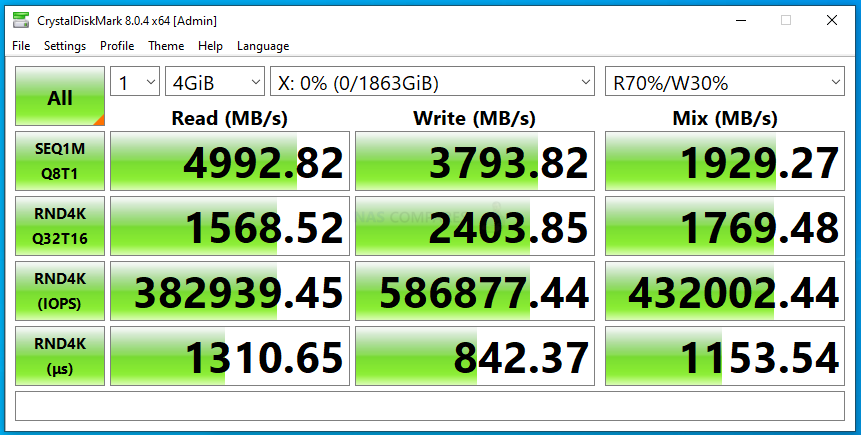
CRYSTALDISK MARK 16GB TEST
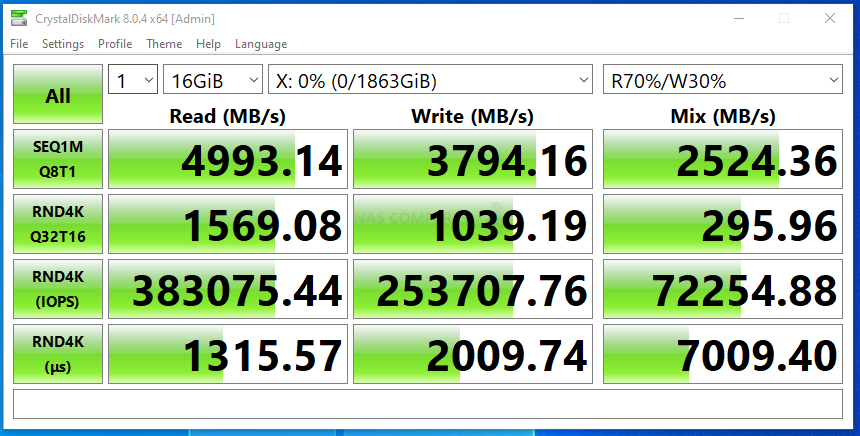
Next, I switched to AS SSD benchmark. A much more thorough test through, I used 1GB, 3GB and 5GB test files. Each test includes throughput benchmarks and IOPS that are respective to the larger file sizes (important, if you are reading this and trying to compare against the reported 4K IOPS from the manufacturer).
AS SSD Benchmark Test #1
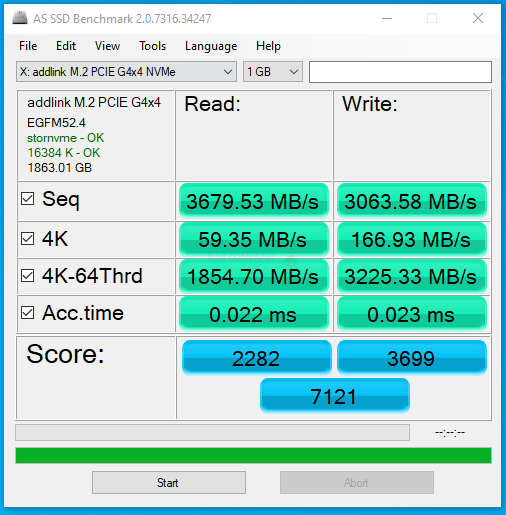 |
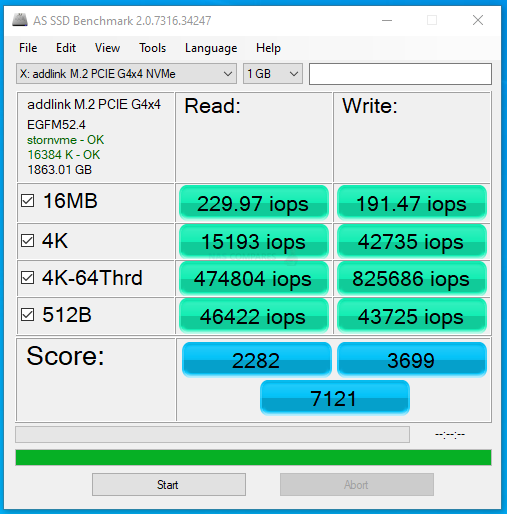 |
AS SSD Benchmark Test #2
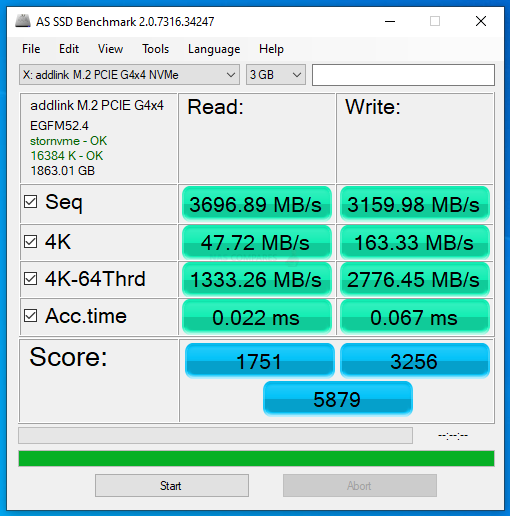 |
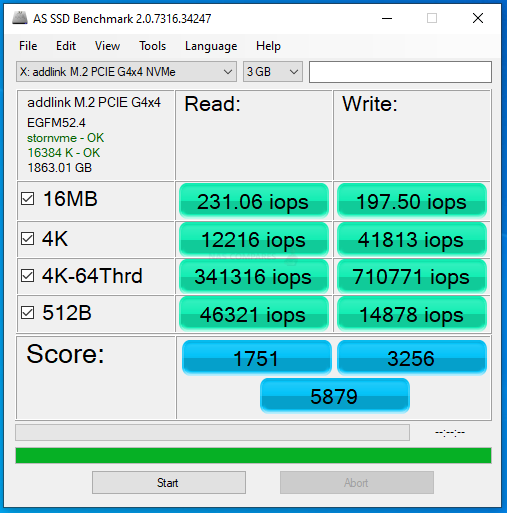 |
AS SSD Benchmark Test #3
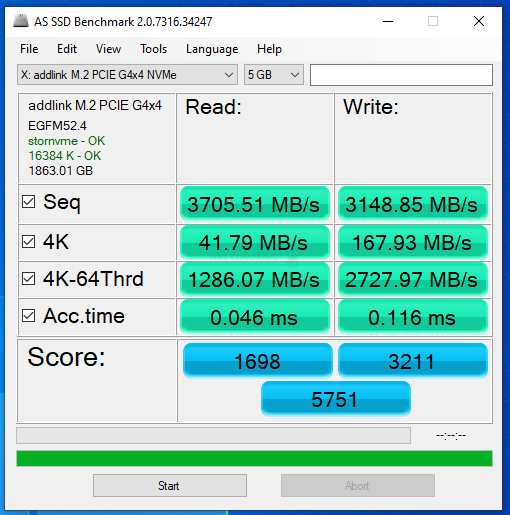 |
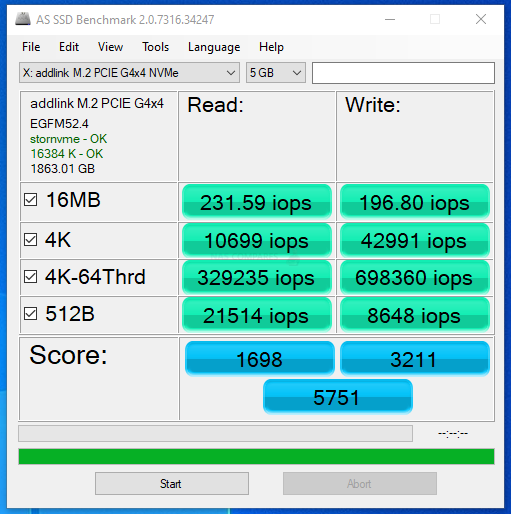 |
Ordinarily, I would introduce tests like BlackMagic and AJA into the mix here, but even a short burst of testing on an NVMe like this would over saturate the cache memory on board. Nevertheless, in the short term we still could ascertain the reported performance on 1GB, 4GB and 16GB file testing was:
1GB AJA File Test Results (Peak) = 4231MB/s Read & 3958MB/s Write

4GB AJA File Test Results (Peak) = 4307MB/s Read & 3935MB/s Write

16GB AJA File Test Results (Peak) = 4350MB/s Read & 3938MB/s Write

Overall, the Addlink A92 was certainly able to provide some solid performance, as well as potentially exceed the test figures here on a more powerful machine. Given the reported Read and Write statistics that the brand has stated publically, I think there is enough evidence here to back up those claims. IOPs were a little lower than I expected, but again, we were testing very large file types, so this would have to be taken in context. Below is the full temperature reading throughout the entire tests, with the SSD and its unique heatsink maintaining a solid temperature of between 40-50 degrees throughout – very impressive for a QLC NAND SSD, though still higher than the A90 and A95 that were tested before it.
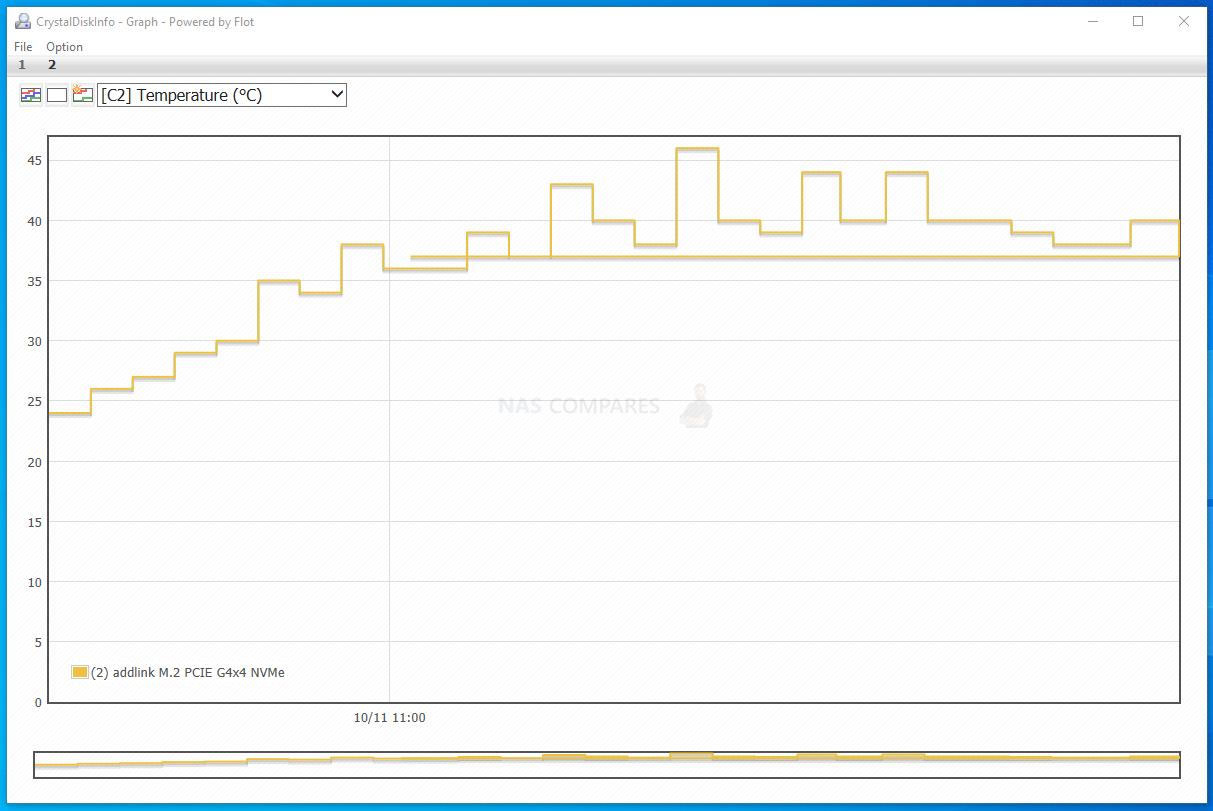
Addlink A92 SSD Review – Conclusion
Fairplay to Addlink – the A92 SSD DEFINITELY works on the PS5. From its confirmed benchmarks to like for like performance comparisons on PS5 (Full tests HERE), it cannot be said that this rather modest QLC M.2 NVMe SSD is not suitable for PS5. Arriving as easily one of the best value SSDs for the PS5 storage expansion upgrade, as well as being one of the highest performing QLC SSDs I have yet to feature on the channel in 2021, I have almost nothing but praise for it. My professional ‘hat’ will tell you that QLC NAND SSD is always to be avoided, as they lack the long term endurance and performance of their TLC alternatives in the market. However, it has to be acknowledged that their utility is much more closed gaming systems like the PS5, where the end-user cannot push these SSDs in particularly hard or any unconventional ways. Therefore there is an argument that QLC NAND SSDs might have finally found their ideal use for most day-to-day users. Of course, the performance of the Addlink A92 in the PS5 seems great now, but we have no idea how much devs are going to push the PS5 hardware in years to come and if the A92 has the staying power in your system to still be a reliable storage upgrade to run your games in 2023-2024. That said, at this price tag, with it’s the inclusive heatsink and arriving at almost half the price of some other brands at the 4TB level, those looking for a much more affordable PS5 SSD upgrade have little to complain about here.
| PROs of the Addlink A92 | CONs of the Addlink A92 |
| Genuinely Impressive Performance on a Phison E16 SSD in PS5 & PC
First Time QLC NAND SSDs might have found a home Inclusive Heatsink and STILL lower in price than the Sabrent Rocket Q4 by around 10% PS5 Benchmark rated at 5,600MB/s+ Lowest Prices 4TB 2280 PCIe4 SSD in the Market |
QLC NAND SSD’s are always a bit of an industry negative and durability is very low
Low Sustained Write Performance
|
🔒 Join Inner Circle
Get an alert every time something gets added to this specific article!
This description contains links to Amazon. These links will take you to some of the products mentioned in today's content. As an Amazon Associate, I earn from qualifying purchases. Visit the NASCompares Deal Finder to find the best place to buy this device in your region, based on Service, Support and Reputation - Just Search for your NAS Drive in the Box Below
Need Advice on Data Storage from an Expert?
Finally, for free advice about your setup, just leave a message in the comments below here at NASCompares.com and we will get back to you. Need Help?
Where possible (and where appropriate) please provide as much information about your requirements, as then I can arrange the best answer and solution to your needs. Do not worry about your e-mail address being required, it will NOT be used in a mailing list and will NOT be used in any way other than to respond to your enquiry.
Need Help?
Where possible (and where appropriate) please provide as much information about your requirements, as then I can arrange the best answer and solution to your needs. Do not worry about your e-mail address being required, it will NOT be used in a mailing list and will NOT be used in any way other than to respond to your enquiry.

|
 |
Beelink ME Pro NAS Revealed
Best SOLID STORAGE NAS of 2025
Should You Worry About the NanoKVM Hidden Microphone?
Best Cheap NAS of 2025
Minisforum MS-02 Ultra - WHO IS THIS FOR??? (The First 48HRs)
Why People Use TrueNAS, UnRAID and Proxmox to Turnkey NAS (Synology, QNAP, etc)
Access content via Patreon or KO-FI





Discover more from NAS Compares
Subscribe to get the latest posts sent to your email.


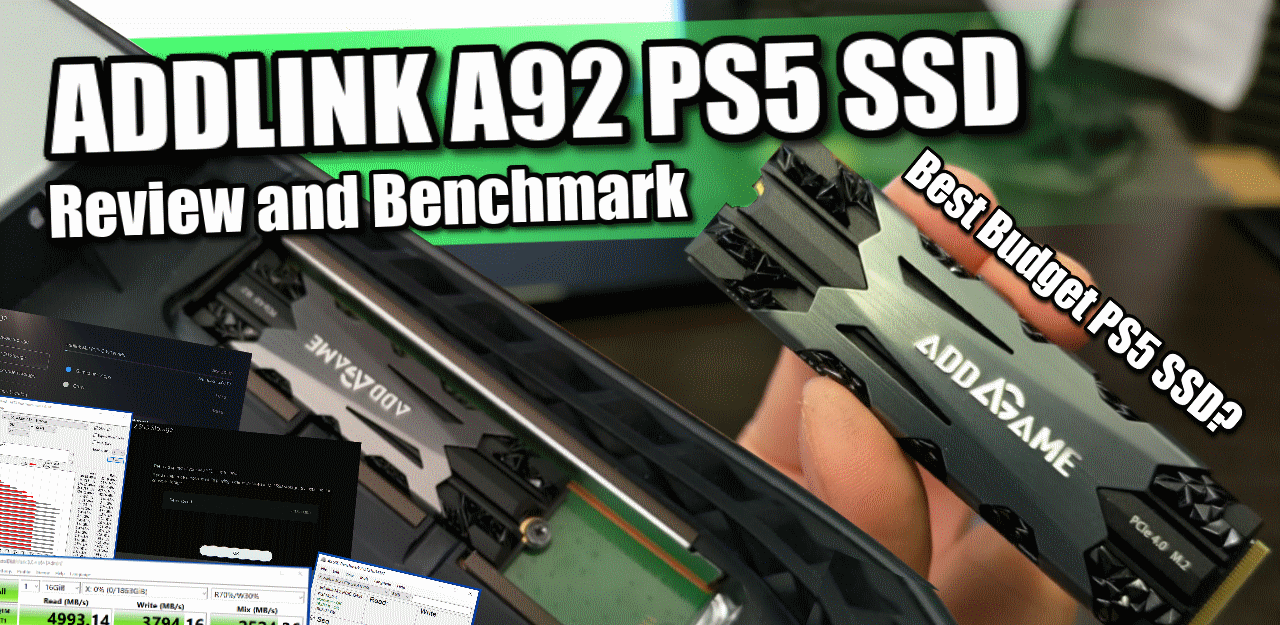

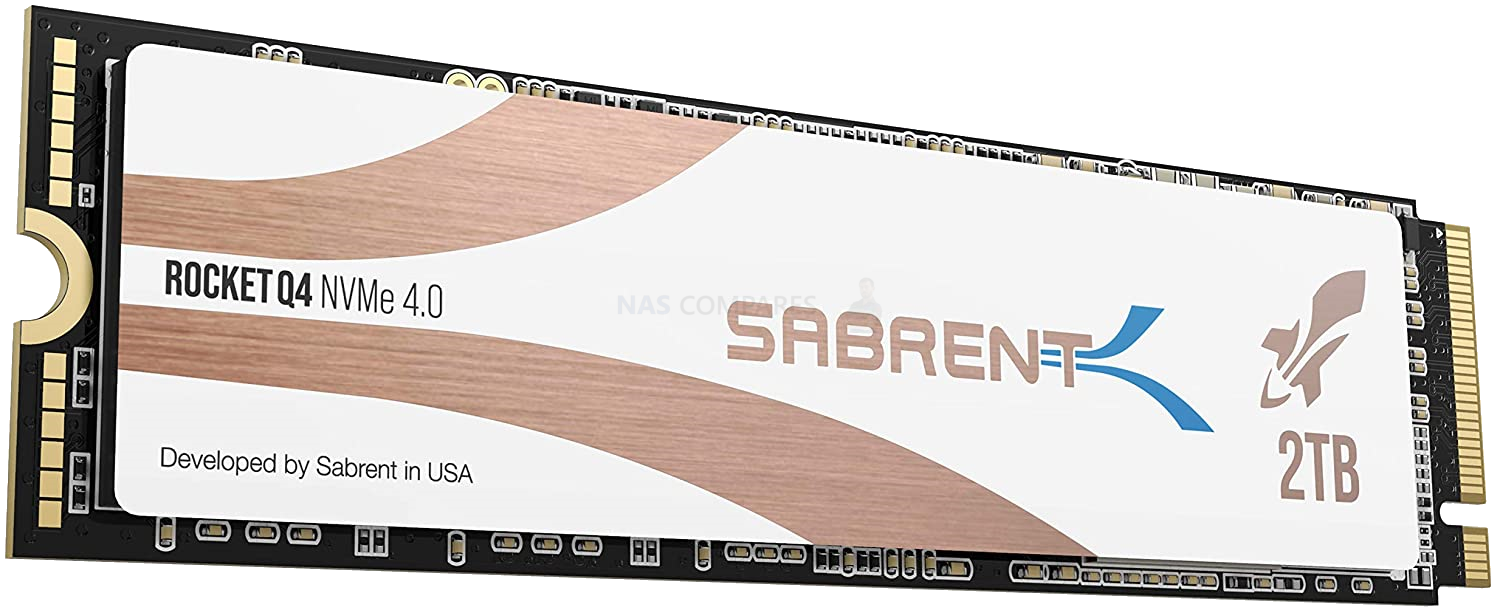




A really good & detailed video ????
REPLY ON YOUTUBE
I bought this one does it have heatsink in it
REPLY ON YOUTUBE
How did you get the 5000+ read speed? I bought the addlink A92 and my PS5 says it’s at 3600+?
REPLY ON YOUTUBE
Hey will you be testing the 4TB A92 also?
REPLY ON YOUTUBE
Hey will you be testing the 4TB A92 also?
REPLY ON YOUTUBE
Where’s the second test then?
REPLY ON YOUTUBE
Can’t wait to see more on this drive I def like the price of it as I’m not a heavy gamer, only concern is durability
REPLY ON YOUTUBE
This is the one I purchased. So far it’s doing it’s job. The fact you are reviewing it gained a sub from me. A bit Naïve about it because it was so cheap but like I said so far can’t complain. Will continue to follow your review of it.
REPLY ON YOUTUBE
I’ve been using this drive (2TB) a couple of weeks now. No performance issues, PS5 fan stays normal speed. Not really noticed any difference in speed compared to internal. Happy so far..
REPLY ON YOUTUBE
I know it’s early in testing, but as of now, could you recommend this ssd as a budget alternative to some of the other models? I’ve been leaning towards getting the WD 850, but only the 1TB because it is more in my budget. BUT if this adequately performs, I could see myself getting the 2TB version of the A92. Thanks for your testing – loads of valuable information!
REPLY ON YOUTUBE
Robbie, would you mind trying out the PNY XLR8 CS3140 on the ps5? I’m seriously thinking of buying this drive for the ps5.
REPLY ON YOUTUBE
Will some of these SSD’s go down in price for Black Friday or Cyber Monday that is what I’m waiting on?
REPLY ON YOUTUBE
Thank you for these tests. Big help.
REPLY ON YOUTUBE
4:16 DAMN… You made a wise decision to keep the ever so scared P.T..
REPLY ON YOUTUBE
Thx for these tests
REPLY ON YOUTUBE
Great! Thnx.
REPLY ON YOUTUBE
If I saw that wallet I’d hire you on the spot and give you a signing bonus for having excellent taste. Keep up the good work.
REPLY ON YOUTUBE
in my opinion the corsair mp600 core is the best budget ssd for ps5
REPLY ON YOUTUBE
Just got my ps5 and I’m loving the vids
REPLY ON YOUTUBE